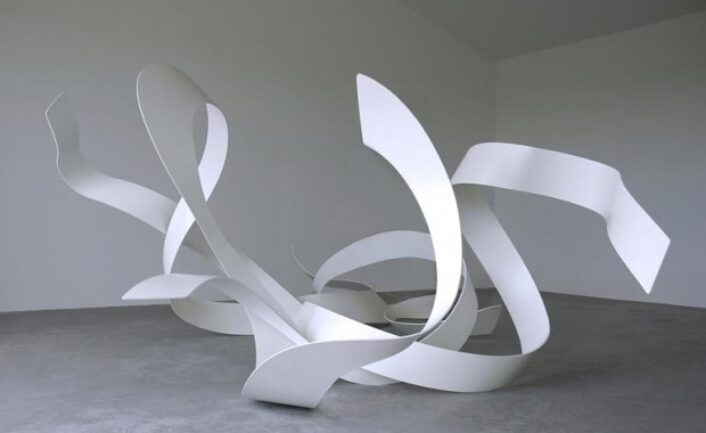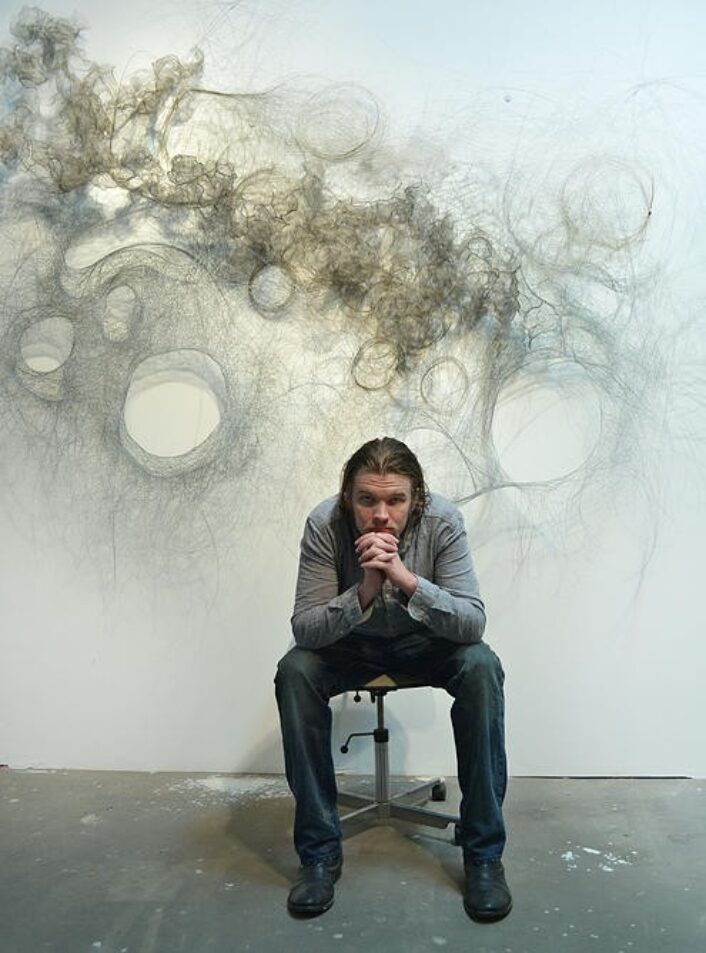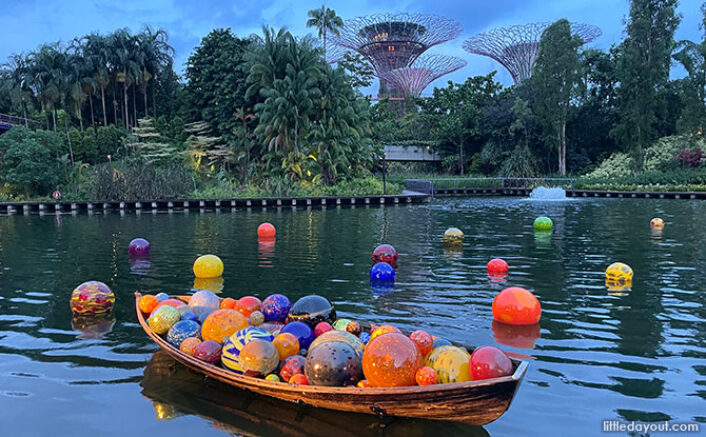How to make a “Knot.”
Fine Art
Jean-Michel Othoniel
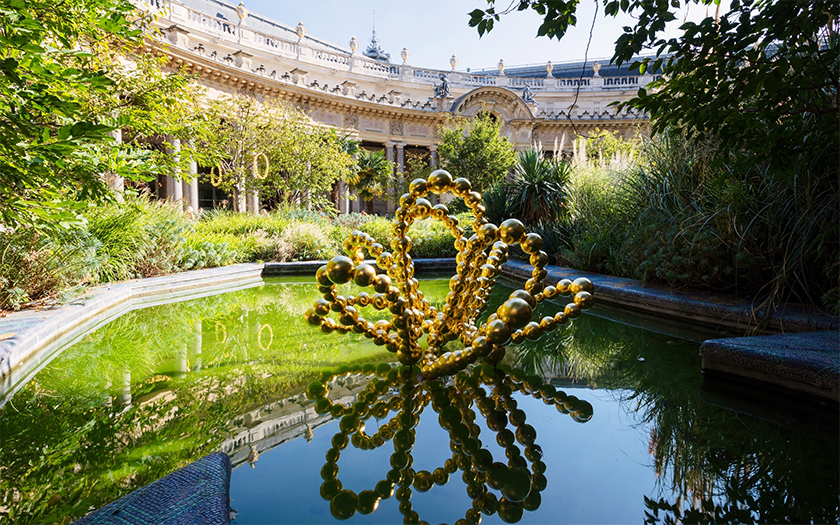
From the recent Narcissus Theorem.
Image courtesy of: Design Boom, photographed by: Claire Dorn
Jean-Michel Othoniel is a conceptual, contemporary French artist that designs pieces of illusion, enchantment, and free-flowing imagination. He has worked with a number of different mediums including drawing, sculpting, and photography; however it is his work with glass that is the most striking. Othoniel has worked with glass since 1993… drawn to the material years ago, he has continuously collaborated with Murano’s artisan glassblowers.
It is the delicacy and subtlety of the colors that inspire Othoniel’s (courtesy of the artist’s web site), “desire to romanticize and re-enchant the world.” In such, 1996 was monumental as Othoniel was granted a residency to perfect his talents at Rome’s Villa Medicis. It was at this time that the artist began to work on large-scale installations, in conjunction to the landscape.
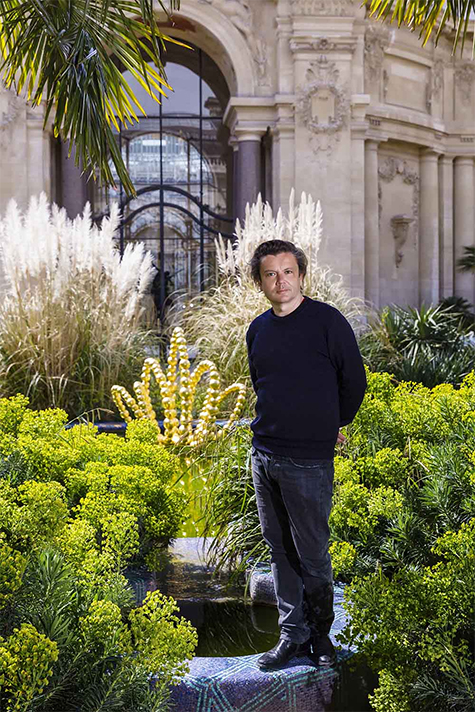
Othoniel standing near “Gold Lotus” at Petit Palais.
Image courtesy of: Galerie Magazine
Recently, Othoniel had the honor of designing an exhibition at Paris’ Petit Palais; interestingly, it was the first time that the museum had given the entirety of Petit Palais to one artist. Coincidently, it was Othoniel’s largest solo exhibition in Paris since 2011… and the world had seen a lot of changes since that time.
As for the venue, over the past three years, the museum’s director, Christophe Leribault, had worked on increasing the amount of contemporary art displayed. Leribault wanted to connect the museum’s collection to lovers of contemporary art; in such, presenting one artist for a big show was ideal. And perfect for the job was Othoniel’s enchanted and jovial work. Leribault said (courtesy of Forbes), “I hope I will make the public dream a little bit.” Yes indeed!
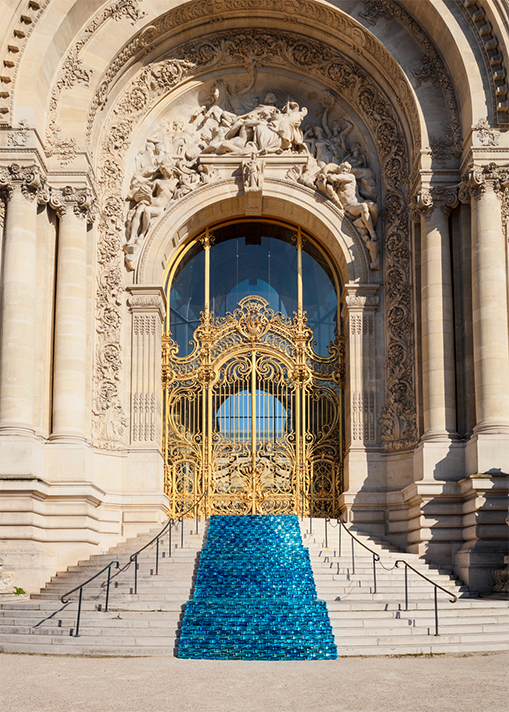
The entrance to Paris’ Petit Palais’ installation, “Blue River.” 1,000 glass bricks made by craftsmen in Firozabad, India welcome visitors to the space. The museum’s architecture played a big part in Othoniel’s selections for the show. The Petit Palais was built for 1900’s World Fair. Following the fair, many buildings were destroyed, however deemed important, the Grand Palais and the Petit Palais remained.
Image courtesy of: Design Boom
Called “Narcissim Theorem,” the exhibition is a body of work versus a retrospective. About half of the pieces were already in existence and residing in South America, Mexico, Canada, and Argentina… but not in Europe. The other half of the sculptures for the show still needed to be produced. Obviously, Othoniel was obliged to take into consideration the building’s architecture when deciding what to include and design.
The first decision was to put the sculptures on the water in order to produce a refection in the water; that effect essentially doubles the pieces. In addition, some of the pieces were also reflective because of their “mirror” surface. During this time, the artist was working with the Aubin Arroyo, a mathematician, about the theory of reflection. Arroyo had worked on this complicated theory for over fifteen years. Taking it one step further and considering the literal sense of the word, Othoniel realized that he needed to study the idea of the importance of reflection in the history of life and in our personal lives. Courtesy of Forbes, the artist continues, “It’s sort of creating a story about this theorem of Narcissus, which is a theorem about reflecting yourself, but also reflecting the world around you. I think this preoccupation is quite important now in the world we are living in today, when you see all the selfies, the use of Instagram.”
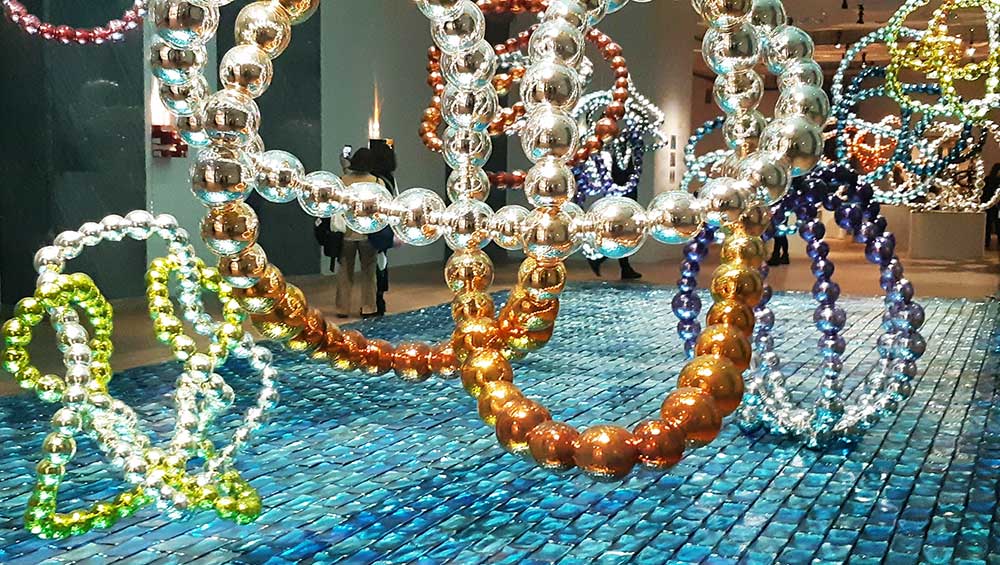
“Wild Knots” hang over a flooring of blue glass bricks. The bricks also appear on the stairs of the museum’s grand entrance.
Image courtesy of: Studio International, photographed by: Ana Beatriz Duarte
The main idea behind the exhibition is for the viewers to enter into an enchanted world… a sort of trip down an unfamiliar yet bewitching rabbit hole. Especially following the pandemic, Othoniel understood the importance, currently more than ever, in connecting with nature as a way to reconnect with ourselves, admire beauty, and ponder. The museum’s beautiful gardens are the perfect arenas to focus inward and to get away from the challenges of the outside world.
Without the artist’s favorite medium, none of this would have been possible. Glass is the perfect channel for Othoniel’s work since he loves its fragility and transparency. In addition, the fact that glass starts off as rough sand, turns into liquid, and then crystallizes into a clear surface that enables light to pierce through is utterly amazing. About the medium and his glass pieces, Othoniel says, “You have to love and cherish glass for it to survive across centuries – just like you have to love my artworks for them to keep on existing. Their strength lies in their fragility.”
One specific sculpture features strung together mirrored-glass balls that were hand-blown in Basel and Murano according to exact specifications. The sculptures float about, suspended above the floor similar to dancers flying through the air. Often considered a master manipulator of glass, Othoniel has come a long way since he became recognized for transforming the entrance of the Palais Royal Metro in 2000.
He continues to leave his mark… especially true at Petit Palais where he donated “The Crown of the Night” to fill a small hole at the top of the ceiling. The director knew something was needed and he loved the piece; unfortunately, it was out of the museum’s budget. He told the artist that “he would buy it and hang it there permanently if the museum could find the money.” As the story continues, Othoniel said, “Listen, Christophe, I am ready to give it to you! The Petit Palais is a free museum, so anyone can come, whenever, just for five minutes, to see my Crown. It was meant to be. Destiny. It had to happen.” And it did!
